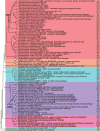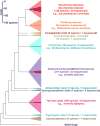Genomics and the making of yeast biodiversity
- PMID: 26649756
- PMCID: PMC4771062
- DOI: 10.1016/j.gde.2015.10.008
Genomics and the making of yeast biodiversity
Abstract
Yeasts are unicellular fungi that do not form fruiting bodies. Although the yeast lifestyle has evolved multiple times, most known species belong to the subphylum Saccharomycotina (syn. Hemiascomycota, hereafter yeasts). This diverse group includes the premier eukaryotic model system, Saccharomyces cerevisiae; the common human commensal and opportunistic pathogen, Candida albicans; and over 1000 other known species (with more continuing to be discovered). Yeasts are found in every biome and continent and are more genetically diverse than angiosperms or chordates. Ease of culture, simple life cycles, and small genomes (∼10-20Mbp) have made yeasts exceptional models for molecular genetics, biotechnology, and evolutionary genomics. Here we discuss recent developments in understanding the genomic underpinnings of the making of yeast biodiversity, comparing and contrasting natural and human-associated evolutionary processes. Only a tiny fraction of yeast biodiversity and metabolic capabilities has been tapped by industry and science. Expanding the taxonomic breadth of deep genomic investigations will further illuminate how genome function evolves to encode their diverse metabolisms and ecologies.
Copyright © 2015 Elsevier Ltd. All rights reserved.
Figures


References
-
- Goffeau A, Barrell BG, Bussey H, Davis RW, Dujon B, Feldmann H, Galibert F, Hoheisel JD, Jacq C, Johnston M, et al. Life with 6000 genes. Science. 1996;274:546,563–567. - PubMed
-
- Cliften P, Sudarsanam P, Desikan A, Fulton L, Fulton B, Majors J, Waterston R, Cohen BA, Johnston M. Finding functional features in Saccharomyces genomes by phylogenetic footprinting. Science. 2003;301:71–76. - PubMed
-
- Kellis M, Patterson N, Endrizzi M, Birren B, Lander ES. Sequencing and comparison of yeast species to identify genes and regulatory elements. Nature. 2003;423:241–254. - PubMed
-
- Kellis M, Birren BW, Lander ES. Proof and evolutionary analysis of ancient genome duplication in the yeast Saccharomyces cerevisiae. Nature. 2004;428:617–624. - PubMed
Publication types
MeSH terms
Grants and funding
LinkOut - more resources
Full Text Sources
Other Literature Sources
Molecular Biology Databases
Miscellaneous

